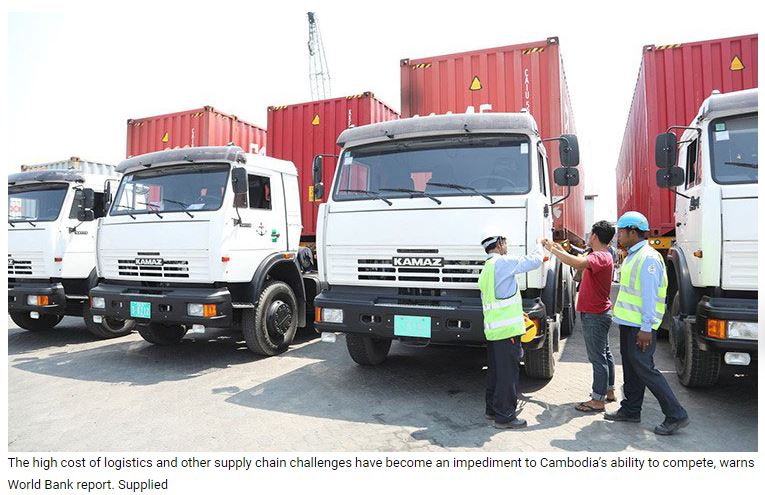‘High logistics cost can harm Cambodia’s export capabilities’
The handling charge for a 40-foot container in Cambodia is double that of neighbouring countries of Thailand and Vietnam while the export clearance fees remain four to five times higher compared to the neighbours, a World Bank report said recently, warning that the cost of logistics in the Kingdom is partially to blame for being a drag on its ability to compete with nearby supply chains for the export market.
A 40-foot container typically runs about $1,200 in handling charges at the terminal in Cambodia, which is up from $1,000 per container pre-Covid-19 and also double that of neighbouring ports in Bangkok in Thailand and Cai Mep in Vietnam, the report said.
Other price differences, where Cambodia runs higher than neighbouring ports, are seen in export clearance fees for containers in the range of $220 to $250, compared to $60 in Thailand and Vietnam
or $50 in Japan.
Meanwhile, average cross-border container costs into Vietnam range anywhere from $217 at the Prey Vor border to $410 at the Bavet border crossing, the report found.
The June economic update on Cambodia, released this month by the World Bank, aimed to look at the country’s goods movement systems as it bounces back from Covid-19 and manages through current headwinds, such as rising fuel prices and the effects of the war in Ukraine.
“The high cost of logistics and other supply chain challenges have become an impediment to Cambodia’s ability to compete, particularly with estimates pointing to companies in the country expected to quadruple the amount of product they’re moving through various transportation channels,” the report said.
“Increasing supply chain reliability and service quality is key to improving Cambodia’s logistics performance, as predictability is not just a matter of time and cost but also a component of shipment quality,” the report added.
The World Bank report provided a number of suggestions for the near and long term in the country, including regular monitoring of ports, boosting rail, automation, incentives to raise logistics industry standards, a hotline people can call into to report violations and supporting e-commerce and other types of specialty logistics.
“The pandemic has resulted in unprecedented global supply chain disruptions, which do not yet show clear signs of waning,” the report said, pointing to the “pressing” need for “transformative reforms” when it comes to the country’s transportation systems if it is to recover from the effects of the pandemic on its garment factories, tourism and exports such as agriculture.
It’s estimated that transportation accounts for nearly 10 percent of overall logistics costs and the price of fuel serves as an additional strain. “Transport operating costs are currently under severe upward pressure due to the high price of diesel, exacerbated by the characteristics of the operators’ fleet,” the report said.
It also described the drayage (transport of freight from an ocean port to a destination) fleets in Cambodia as dating “back to the last century,” consisting of second-hand and third-hand models from Korea and Vietnam.
“Upgrading the goods vehicle fleet should be seen as a priority from both a logistics cost perspective and an environmental perspective, as there is an urgent need to burn less and cleaner fuel of a higher grade than at present,” the report said.
Duties and fees run anywhere from 35 percent to 65 percent, making it difficult for trucking companies to make the investment in newer vehicles, it added.
Even as demand slowed, the country’s merchandise exports made gains in the first quarter, led by garments, travel-related products and footwear. The three sectors combined to total $3.1 billion in the quarter, up 25.2 percent from the year-ago period.
Cambodia’s garment exports grew 20.4 percent in the first quarter from a year ago to total $2.1 billion while its economy is projected to grow 4.5 percent this year, albeit the recovery is expected to be “uneven,” according to the report, which added “increased integration into regional and global value chains has made efficient logistics and supply chains central to Cambodia’s development strategy.”
Source: https://www.khmertimeskh.com/501117432/high-logistics-cost-can-harm-cambodias-export-capabilities/


 Thailand
Thailand




